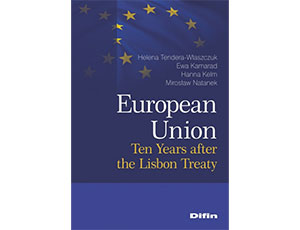
Książka poświęcona jest prezentacji funkcjonowania Unii Europejskiej w 10 lat po wejściu w życie Traktatu Lizbońskiego. Przedmiotem rozważań są w szczególności zmiany instytucjonalne wprowadzone Traktatem Lizbońskim, ze szczególnym uwzględnieniem Rady Europejskiej.
Ponadto autorzy analizują zapisu Traktatu Lizbońskiego pod względem możliwości przeciwdziałania kryzysowi w strefie euro. Oceniono również wpływ realizowanego modelu państwa dobrobytu na efektywność niwelowania różnic w poziomie rozwoju społeczno-gospodarczego w nowych Państwach Członkowskich w stosunku do „starej” piętnastki. Ostatnia część książki poświęcona jest ocenie Artykułu 50 Traktatu Lizbońskiego, umożliwiającego wyjście kraju z Unii Europejskiej, na podstawie doświadczeń Wielkiej Brytanii.
Spis treści:
Introduction
Chapter 1. An Attempt to Assess the Selected Reforms of the EU Institutional System with Particular Regard to the European Council
Introduction
1.1. Institutional reforms – the example of the European Council
1.2. Conclusions
Literature
Chapter 2. The role of the Lisbon Treaty in Facing the Crisis in the Euro Zone
Introduction
2.1. The theoretical backgrounds of the euro zone
2.2. The financial crisis and its tension in the European economies
2.2.1. The state of public finances – deficit and level of debt – in the GIPSY countries
2.3. The Stability and Growth Pact (SGP)
2.4. Facing a crisis in the Lisbon Treaty
2.5. Conclusions
Literature
Chapter 3. The impact of the implemented welfare state concept on leveling the socio-economic distance of the European Union new Member States to the EU-15
Introduction
3.1. The implementation of different welfare state models in the EU Member States: a theoretical approach
3.2. Analysis and assessment of the effectiveness of leveling the socio-economic distance of NMS to EU-15 Member States
3.3. Conclusions
Literature
Chapter 4. The withdrawal of a Member State from the European Union in the light of Article 50 TEU on the example of the United Kingdom
Introduction
4.1. Possibility of a Member State's withdrawal from the European Union
4.1.1. Before the adoption of the Lisbon Treaty
4.1.2. After the adoption of the Lisbon Treaty
4.2. The procedure for the withdrawal of a Member State from the European Union
4.2.1. Undertaking a decision on the withdrawal
4.2.2.The notification of the intention to withdraw submitted to the European Council
4.2.3. Negotiations of a country withdrawing from with the EU
4.2.4. The agreement of withdrawal from the EU
4.3. A lack of Withdrawal Agreement
4.4. The effects of a Member State's withdrawal from the EU
4.5. The withdrawal of the United Kingdom from the European Union
4.5.1. Arguments for and against the withdrawal
4.5.2. Referendum on the Brexit
4.5.3. Decision to withdraw from the EU
4.5.4. Possible forms of cooperation between the United Kingdom and the European Union after the Brexit
4.6. Negotiations on the withdrawal
4.7. Conclusions
Literature

